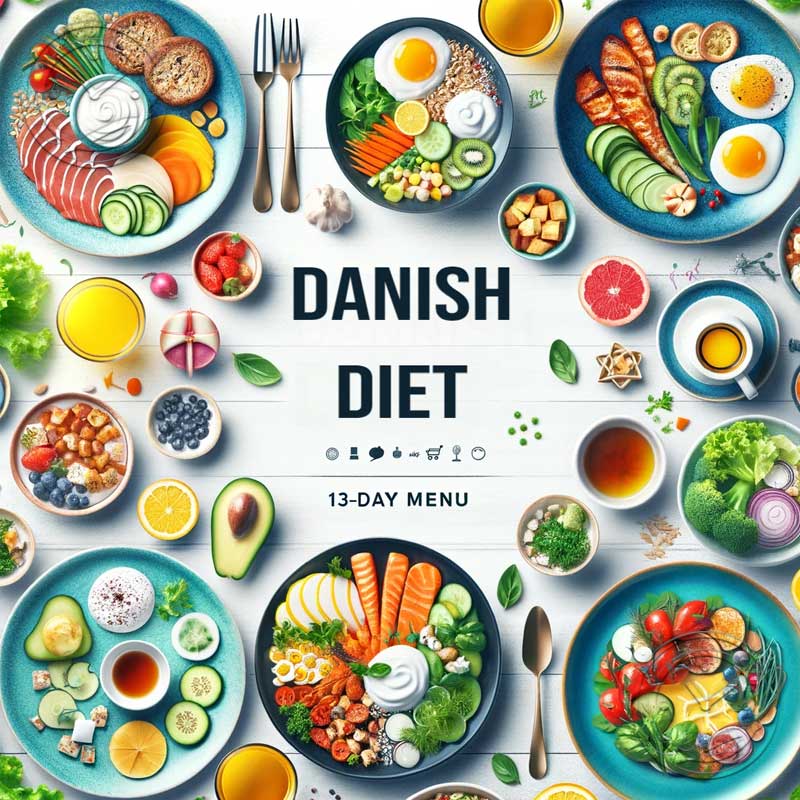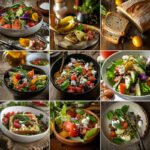Introduction to the Danish Diet
Originating from Denmark, the Danish diet, sometimes called the Copenhagen diet, is an intriguing yet highly restrictive 13-day eating plan.
It’s known for its low-calorie and low-carbohydrate approach, promising rapid weight loss.
Each day in this diet is meticulously planned, with specific foods and portion sizes to be adhered to.
Despite its structured approach, the Danish diet raises several eyebrows in the nutrition community due to its extreme nature.
It’s vital for anyone considering this diet to understand its intricacies, potential impacts on health, and the importance of approaching it with caution.
The Health Benefits of Danish Diet
While the Danish diet is often sought after for its quick weight loss results, it’s essential to critically evaluate its health benefits.
The diet’s low-calorie count can lead to rapid weight loss, which may initially seem beneficial for those seeking quick results.
However, the diet’s highly restrictive nature means that it’s typically low in essential nutrients, potentially leading to deficiencies if followed for an extended period.
This can have various side effects, including fatigue and muscle loss.
It’s crucial to weigh these factors and consult healthcare professionals before starting such a stringent diet.
Explore the fascinating world of the Danish diet history on Minute 4 Me! Bursting with fresh fruits, vegetables, and fish,…
Danish Diet Menu for 13 Days
The Danish diet is characterized by a strictly regimented menu that spans 13 days.
Each day focuses on specific food groups, ranging from fruits to proteins, with the aim of reducing calorie intake while attempting to maintain a balance of nutrients.
The diet includes:
- Days 1 and 2: Fruit-focused days, emphasizing apples, oranges, grapefruit, and pears.
- Day 3: A day dedicated to non-starchy vegetables, with an allowance for a slice of whole-wheat toast.
- Day 4: A protein-centric day, incorporating lean protein sources with non-starchy vegetables.
- Day 5: A combination of fruits, vegetables, and lean proteins.
- Day 6: A mix of lean protein and starchy vegetables.
- Day 7: Non-starchy vegetables paired with healthy fats.
This cyclical pattern is repeated for the remaining days (Day 8 to Day 13), following the guidelines set from Day 4 to Day 7.
Day-by-Day Meal Plan
19 Low-Sugar DASH Diet Breakfast Recipes
Discover the secret to starting your day right with our collection of 19 Low-Sugar DASH Diet Breakfast Recipes! Delve into…
Day 1:
- Breakfast: Start with a selection of fruits like apples and pears, coupled with unsweetened coffee or tea. This combination provides a light, refreshing start to the day.
- Lunch: Midday, introduce more fruits such as oranges and grapefruits, focusing on hydration and fiber intake.
- Dinner: Conclude the day with a diverse mix of fruits. This not only adds variety but also helps in keeping up with the diet’s demands.
Day 2:
- Breakfast: Continue with a fruit-based breakfast, perhaps including a wider variety of fruits to maintain interest and nutritional variety.
- Lunch: A fruit salad combining different types, such as berries and melons, can offer a refreshing and hydrating meal.
- Dinner: Finish the day with a careful selection of fruits, ensuring you’re getting a range of flavors and nutrients.
Flexitarian Diet 7-Day Meal Plan
Dive into a 7-day meal plan filled with delicious and nutritious options, explore the health benefits it brings, and learn…
Day 3:
- Breakfast: A light breakfast of spinach and a slice of whole-wheat toast, accompanied by unsweetened coffee or tea, starts this vegetable-focused day.
- Lunch: For lunch, a salad made from lettuce, celery, and tomatoes provides essential vitamins and fiber.
- Dinner: Dinner can include a variety of cucumbers and another slice of whole-wheat toast for a balance of crunch and wholesomeness.
Day 4:
- Breakfast: Begin with scrambled eggs mixed with spinach, providing a good balance of protein and greens.
- Lunch: A satisfying lunch could be a grilled chicken breast with a side salad of non-starchy vegetables.
- Dinner: Conclude with a light dinner of baked fish and a mixed vegetable salad, focusing on lean protein and fiber.
Day 5:
- Breakfast: Combine fruits with boiled eggs, providing a balance of natural sugars, protein, and essential fats.
- Lunch: A mixed vegetable salad with grilled chicken strips offers a fulfilling midday meal.
- Dinner: Balance out the day with a combination of fruits, vegetables, and a choice of protein, ensuring a variety of nutrients.
Day 6:
- Breakfast: An omelet with spinach makes for a protein-rich start to the day.
- Lunch: Grilled chicken with a small portion of potatoes provides a balanced meal of protein and carbs.
- Dinner: Conclude with fish accompanied by a side of corn, ensuring a good mix of protein, fiber, and carbohydrates.
Day 7
- Breakfast: A nutritious start with an avocado salad dressed in olive oil provides healthy fats and fiber.
- Lunch: Midday, opt for a variety of steamed non-starchy vegetables, perhaps seasoned with herbs and a drizzle of olive oil for flavor.
- Dinner: End the day with a colorful array of vegetables, such as bell peppers and zucchini, accompanied by a modest amount of healthy fats.
Day 8
- Breakfast: Revisiting the protein theme, start with scrambled eggs accompanied by spinach or kale for a nutrient-rich meal.
- Lunch: A satisfying lunch could include grilled fish with a side of asparagus or green beans.
- Dinner: For dinner, opt for a lean protein like turkey or tofu, served with a side of mixed vegetables.
Day 9
- Breakfast: A vegetable omelet made with egg whites and a variety of greens like spinach and bell peppers.
- Lunch: Grilled chicken or tofu served with a large salad of leafy greens and non-starchy vegetables.
- Dinner: A light meal of baked fish with steamed broccoli or cauliflower to maintain a balance of protein and fiber.
Day 10
- Breakfast: Begin the day with boiled eggs and a side of mixed berries for a blend of protein and antioxidants.
- Lunch: A salad with mixed greens, cherry tomatoes, cucumbers, and grilled shrimp or a plant-based protein alternative.
- Dinner: Conclude with a portion of grilled lean beef or lentil patties, served with a side of green beans.
Day 11
- Breakfast: A smoothie made with spinach, a small banana, and protein powder can offer a refreshing start.
- Lunch: For lunch, consider a chicken or chickpea salad with a variety of vegetables and a light vinaigrette.
- Dinner: A wholesome meal of baked salmon or grilled tofu, accompanied by a salad or steamed vegetables.
Day 12
- Breakfast: Start with a bowl of mixed fruits, focusing on low-calorie options like berries and melon.
- Lunch: A nutritious lunch of turkey breast or a vegetarian patty with a side of roasted non-starchy vegetables.
- Dinner: End the day with a light stir-fry using lean protein sources and a medley of colorful vegetables.
Day 13
- Breakfast: A protein-packed start with poached eggs and sautéed spinach or kale.
- Lunch: Grilled fish or a bean-based patty served with a large, leafy green salad.
- Dinner: Conclude the diet with a satisfying meal of chicken or tempeh, paired with steamed vegetables like broccoli or Brussels sprouts.
Tips for Success on the Danish Diet
Succeeding on the Danish diet requires careful planning and mindfulness.
Here are some tips:
- Stay Hydrated: Water is key. Aim to drink at least 8 glasses per day.
- Portion Control: Adhere strictly to portion sizes to maintain the low-calorie aspect of the diet.
- Prepare in Advance: Meal prep can help you stay on track and avoid the temptation of off-plan foods.
- Listen to Your Body: Be attentive to how your body reacts and consult a professional if you experience adverse effects.
- Transition Gently: After completing the diet, gradually reintroduce other foods to avoid shocking your system.
Conclusion
The Danish diet is a structured, short-term approach to weight loss.
While it can lead to rapid results, it’s crucial to approach it with an understanding of its limitations and potential health risks.
Long-term success in weight loss and maintenance lies in sustainable, balanced eating habits and a healthy lifestyle.
This diet should be considered a temporary measure and not a long-term solution.
For lasting results, focus on a balanced diet, regular physical activity, and consult healthcare professionals for personalized advice.







